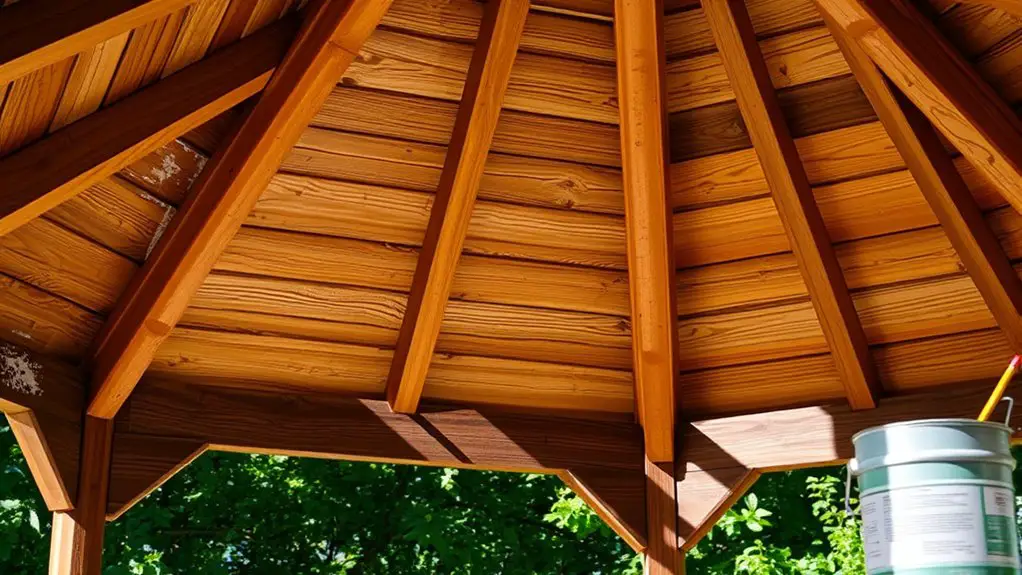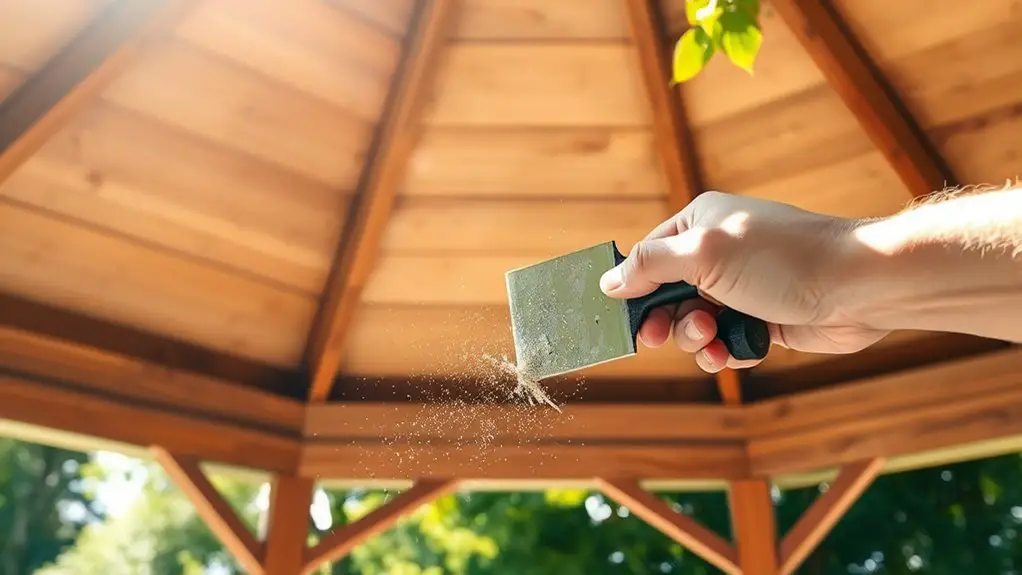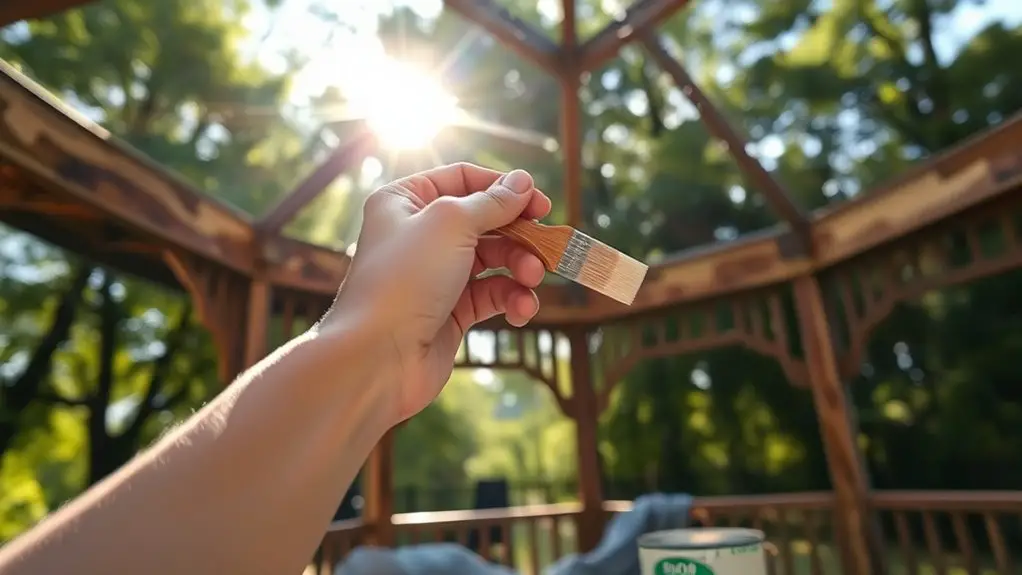To repaint your gazebo without damaging the surface, start by thoroughly inspecting it for any damage like rot or rust. Clean it well to remove debris and old paint, then choose the right paint—acrylic latex or oil-based enamel are great options. Use quality tools and apply multiple thin coats for even coverage. Don’t forget to let it dry and cure properly. There’s plenty more to contemplate for a successful project ahead!
Assessing the Condition of Your Gazebo

Before diving into the painting process, it’s essential to assess the condition of your gazebo. Start with a thorough gazebo inspection. Look for any signs of damage, such as rot, rust, or loose boards. Pay close attention to joints and connections, as these areas often bear the brunt of wear and tear.
Next, conduct a surface evaluation. Check if the existing paint is peeling, cracking, or fading, as these issues can affect how well your new paint adheres. If you find any mold or mildew, take note; it needs addressing before you can paint. It’s also crucial to perform regular inspections to ensure all aspects of the gazebo are in good condition before repainting.
Choosing the Right Paint for Your Gazebo
Choosing the right paint for your gazebo can make all the difference in achieving a long-lasting, beautiful finish. You’ll want to reflect on paint finish options that complement your style while ensuring durability. Here’s a quick guide to help you decide:
| Paint Type | Weather Resistance Factors |
|---|---|
| Acrylic Latex | Excellent UV resistance, water-based |
| Oil-based Enamel | Superior durability, resistant to moisture |
| Solid Stain | Penetrates wood, provides protection from rot |
Acrylic latex paints are great for flexibility and color retention, while oil-based enamels offer a hard, glossy finish. Solid stains protect wood while enhancing its natural beauty. Additionally, it’s essential to consider weather resistance when evaluating your gazebo’s exposure to the elements and select a paint that balances aesthetics with weather resistance factors. With the right choice, you’ll enjoy your gazebo for years to come!
Essential Tools and Materials for Repainting

Before you start repainting your gazebo, it’s vital to gather the right tools and materials. You’ll need essential painting supplies, safety gear to protect yourself, and surface preparation tools to guarantee a smooth finish. Let’s take a look at what you’ll need to make this project a success.
Required Painting Supplies
When you’re ready to repaint your gazebo, gathering the right supplies is essential for achieving a professional-looking finish. Start with a thorough pre painting inspection to identify any areas needing repair or prep work. You’ll need high-quality exterior paint suitable for your gazebo’s material, plus primer if necessary. Grab tools like brushes, rollers, or a sprayer—each offers different paint application techniques to suit your style. Don’t forget a paint tray, drop cloths, and painter’s tape for clean lines. A ladder is handy for those hard-to-reach spots, while sandpaper or a scraper helps with surface prep. With these supplies ready, you’ll set the stage for a successful repainting project that lets your creativity shine.
Safety Gear Essentials
While you’re gearing up to repaint your gazebo, don’t overlook the importance of safety gear. Wearing the right protective clothing not only keeps you safe but also enhances your painting experience. Here’s a quick reference table for essential safety gear:
| Item | Purpose | Recommendation |
|---|---|---|
| Safety Goggles | Protects eyes from splashes | Use ANSI-approved goggles |
| Respirator Mask | Filters harmful fumes | Opt for N95 or better |
| Gloves | Shields hands from paint | Choose chemical-resistant gloves |
| Coveralls | Prevents paint on clothes | Wear breathable material |
Investing in safety gear guarantees you can enjoy the freedom of painting without worrying about potential hazards. So, gear up and get ready to transform your gazebo!
Surface Preparation Tools
Having your safety gear on is just the start; now it’s time to gather the right tools and materials for surface preparation. Using the right essential prep tools can make a significant difference in your repainting project. Here are some must-haves for effective surface preparation strategies:
- Wire brush: To remove loose paint and rust.
- Sandpaper: For smoothing rough spots and existing paint.
- Putty knife: To scrape off any remaining debris.
- Drop cloths: Protect the ground and surrounding areas.
- Cleaning solution: To guarantee the surface is free from grime.
With these tools in hand, you’ll be well-equipped to prep your gazebo for a fresh coat of paint that lasts!
Preparing the Surface for Painting

Before you start painting your gazebo, you’ll need to prepare the surface properly. Begin by giving it a thorough cleaning to remove dirt, debris, and old paint. Next, inspect for any damage that might need repairs to guarantee a smooth and lasting finish. Regular cleaning helps prevent mould growth, ensuring the surface is in optimal condition for painting.
Clean the Gazebo Thoroughly
A thorough cleaning of your gazebo is essential for achieving a smooth and lasting paint job. By using effective cleaning techniques, you can guarantee that the surface materials are primed for painting. Here’s how to get started:
- Remove loose debris and dirt with a broom.
- Use a pressure washer or hose for stubborn grime.
- Apply a gentle cleaning solution to eliminate mildew or stains.
- Rinse thoroughly to avoid residue that can affect adhesion.
- Allow the gazebo to dry completely before painting.
Inspect for Damage
Once you’ve cleaned your gazebo, it’s crucial to inspect it for any damage that might compromise your paint job. Conducting a thorough damage assessment will help you identify issues like rot, cracks, or peeling. A proper surface inspection guarantees your gazebo’s longevity and aesthetics.
Here’s a simple table to guide you through common issues:
| Damage Type | Recommended Action |
|---|---|
| Rot | Replace affected wood |
| Cracks | Fill with wood filler |
| Peeling Paint | Scrape and sand down |
Addressing these problems before painting helps create a smooth and durable finish. Remember, taking the time to assess damage now will save you from larger headaches later on, giving your gazebo the freedom to shine.
Proper Techniques for Painting Wood Gazebos
While it may seem straightforward, painting a wooden gazebo requires careful preparation and technique to guarantee a long-lasting finish. To achieve the best results, follow these essential steps:
- Clean the surface: Remove dirt, debris, and old paint. A power washer can be helpful.
- Apply wood treatments: Use a wood preservative to protect against rot and insects before painting.
- Seal the surface: A good surface sealing product creates a protective barrier, ensuring the paint adheres properly.
- Choose quality paint: Opt for exterior paint that’s designed for wood, providing durability and weather resistance.
- Use the right tools: Brushes and rollers suited for the type of paint you’re using will give you a smoother finish.
- Ensure the wood’s moisture content is below 20% moisture content to prevent paint issues.
Taking these steps will not only enhance the appearance of your gazebo but also extend its life, allowing you to enjoy your outdoor space freely for years to come.
Repainting Metal Gazebos: Tips and Tricks
When it comes to repainting metal gazebos, preparation is key to achieving a durable and attractive finish. Start by thoroughly cleaning the metal surface to remove any dirt, rust, or old paint. A wire brush or sandpaper can help you achieve a smooth base. Next, apply a rust-inhibiting primer to enhance paint adhesion. This step is essential; without it, your new paint might peel or chip. Once the primer dries, choose a high-quality exterior paint designed for metal. Spray paint can offer an even finish, but a brush or roller can work just as effectively. When painting, use light, even strokes to avoid drips and guarantee full coverage. Don’t forget to let each coat dry completely before applying the next. With these tips, you’ll enjoy a refreshed gazebo that stands strong against the elements and looks great in your outdoor space!
How to Handle Composite Materials
When repainting a gazebo made of composite materials, proper surface preparation is key to achieving a long-lasting finish. You’ll want to clean the surface thoroughly and guarantee it’s free of any dirt or debris before applying paint. Choosing the right paint specifically designed for composite materials will also make a big difference in durability and appearance.
Proper Surface Preparation
Proper surface preparation is essential for achieving a smooth and durable finish on your gazebo, especially when dealing with composite materials. To guarantee your prep techniques are effective, follow these steps tailored for various surface types:
- Clean the surface thoroughly to remove dirt and grime.
- Sand down rough areas to create a smooth base.
- Check for any signs of damage or wear, and repair as needed.
- Apply a primer specifically designed for composite materials to enhance paint adhesion.
- Allow the surface to dry completely before applying your chosen paint.
Choosing the Right Paint
After prepping the surface of your gazebo, the next important step is selecting the right paint, especially for composite materials. You’ll want to choose a paint specifically formulated for these types of surfaces, as it guarantees better adherence and longevity. When it comes to color selection, consider the overall aesthetic you’re aiming for; lighter colors can brighten up your space, while darker tones may add sophistication. Remember, paint durability is key—look for options that resist fading, peeling, and mildew. Always check for UV resistance, too, so your gazebo stays vibrant through the seasons. Trust me, taking the time to choose the right paint will pay off, giving your gazebo a fresh, long-lasting look you can enjoy for years.
Techniques for Even Application
Achieving an even application of paint on your gazebo can make all the difference in the final look. Whether you’re using spray application or brush techniques, there are some key strategies to guarantee a smooth finish. Here are a few tips to keep in mind:
- Prep the surface: Clean and sand the gazebo to eliminate any imperfections.
- Use quality tools: Invest in a good brush or sprayer for better control.
- Apply thin coats: Multiple light layers are better than one heavy coat.
- Maintain a consistent distance: When spray painting, hold the sprayer at a steady distance to avoid drips.
- Work in sections: Focus on one area at a time to guarantee even coverage.
- Consider weather protection: Using weather-resistant covers can help maintain the gazebo’s surface during painting and prevent damage from the elements.
Drying and Curing: What to Know
Once you’ve applied your paint, understanding the drying and curing process is essential to ensuring a lasting finish. Drying time can vary depending on factors like temperature, humidity, and the type of paint you’ve chosen. Generally, most paints will dry to the touch within a couple of hours but may take longer to cure fully.
The curing process is vital; it allows the paint to harden and bond with the surface, which can take several days to weeks. During this time, avoid heavy contact with the gazebo to prevent any damage to the fresh finish.
If you’re in a hurry, consider using quick-dry paints, but remember that rushing can compromise durability. Keep an eye on the weather, as rain or high humidity can prolong drying times. By respecting these drying and curing stages, you’re giving your gazebo the freedom to shine for years to come!
Maintaining Your Gazebo Post-Painting
Maintaining your gazebo after painting is essential for preserving its beauty and longevity. With some simple post painting care, you can keep your gazebo looking fresh for years to come. Here are a few maintenance tips to take into account:
- Regular Cleaning: Wipe down surfaces with a gentle soap solution to remove dirt and debris.
- Inspect for Damage: Check for any signs of chipping or peeling to address issues early.
- Reapply Sealant: Use a sealant every couple of years to protect the paint from the elements.
- Trim Surrounding Vegetation: Keep branches and plants at bay to prevent scratches and moisture buildup.
- Monitor for Mold or Mildew: Address any growth immediately with a mild cleaning solution. Additionally, applying waterproofing agents can help prevent moisture-related damage and extend the life of your gazebo.
Frequently Asked Questions
How Often Should I Repaint My Gazebo?
You should repaint your gazebo every 3 to 5 years, depending on wear and weather. For effective gazebo maintenance, choose high-quality paint that withstands the elements, ensuring your outdoor retreat remains beautiful and inviting.
Can I Paint Over Old Paint?
Absolutely, you can paint over old paint! Just make certain you properly prepare the surface. Scrape, sand, and clean it well. Choosing the right paint types will help achieve a fresh finish that lasts beautifully.
What Is the Best Time of Year to Repaint?
The best time to repaint’s often spring or fall. During these seasons, weather’s mild, reducing the risk of paint issues. Consider humidity and temperature; you want ideal conditions for a smooth, lasting finish you’ll love.
How Do I Remove Paint Drips or Spills?
To remove paint drips or spills, you’ll want to use a gentle paint remover. Always protect the surface with masking tape or drop cloths, ensuring you maintain that fresh look while avoiding damage during the cleanup.
Is It Necessary to Use a Primer?
Using a primer isn’t strictly necessary, but it offers benefits like improved adhesion and enhanced color vibrancy. Different primer types cater to various surfaces, so choosing the right one can elevate your painting project considerably.

